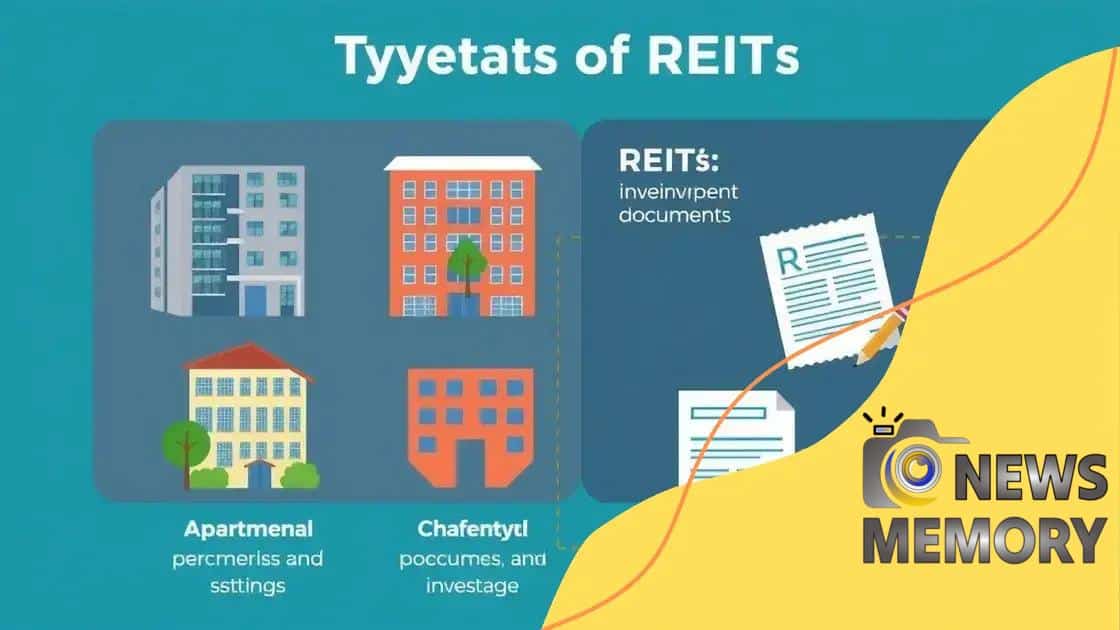The role of real estate investment trusts (REITs) in portfolio diversification

The role of real estate investment trusts (REITs) in portfolio diversification allows investors to gain exposure to real estate markets and generate income, while managing risks through various types of REITs available.
The role of real estate investment trusts (REITs) in portfolio diversification has gained traction among investors. Have you considered how incorporating REITs can enhance your investment strategy?
Understanding REITs and their structure
Understanding real estate investment trusts (REITs) is essential for any investor looking to diversify their portfolio. These unique investment vehicles allow individuals to invest in real estate without having to buy properties directly. But what does that mean for you as an investor?
REITs operate by pooling capital from various investors to purchase, manage, and sell income-generating real estate. This structure offers significant advantages, including liquidity and the potential for regular income distributions. As you explore this investment option, it’s important to recognize their structure and functionality.
Types of REITs
There are three primary types of REITs, each serving different investment strategies:
- Equity REITs: These invest in and manage income-producing properties. They generate revenue primarily from leasing space and collecting rents.
- Mortgage REITs: These provide financing for income-producing real estate by purchasing or originating mortgages and mortgage-backed securities.
- Hybrid REITs: A combination of equity and mortgage REITs, these offer a diversified investment strategy by providing both capital for property purchasers and collecting rents.
Understanding these types will help you make informed decisions on which REIT aligns with your investment goals. The structure of REITs also allows for a more hands-off investment approach compared to owning physical property. There are no tenants to manage, and you benefit from professional management and diversification across multiple properties.
Moreover, REITs can be traded on major stock exchanges, providing liquidity similar to stocks. This characteristic is particularly appealing for investors looking for flexibility in their investment strategies. Since investors can buy and sell shares of REITs easily, they can react quickly to market conditions without being tied down to real estate assets.
In summary, the understanding of REITs and their structure is integral for realizing their potential benefits in a diversified portfolio. By incorporating various types of REITs, investors can access unique opportunities in real estate while minimizing associated risks.
Benefits of REITs for portfolio diversification
Benefits of real estate investment trusts (REITs) for portfolio diversification are numerous and impactful for investors. Integrating REITs into your investment strategy can enhance risk management while providing exposure to the real estate sector.
One of the most significant advantages of REITs is that they allow investors to gain access to real estate markets without the need for large capital. This is especially important for those starting their investment journey. By pooling resources, REITs enable individuals to invest in a variety of properties such as commercial buildings, apartments, and healthcare facilities.
Key Advantages of Investing in REITs
Several key benefits make REITs a compelling choice for diversification:
- Income Generation: REITs are required to distribute at least 90% of their taxable income as dividends. This results in regular income payments for investors.
- Diversification: By investing in a REIT, you can access a variety of properties. This reduces the risk associated with investing in a single property.
- Liquidity: Publicly traded REITs offer the ability to buy and sell shares easily, providing flexibility that is not available in direct real estate investments.
- Professional Management: REITs are managed by experienced professionals who handle property acquisition, management, and compliance, saving investors time and effort.
Investing in REITs also brings the benefit of inflation protection. Real estate often appreciates over time, which can help counteract inflation. Additionally, the ability to diversify across various sectors within real estate mitigates risks related to economic downturns.
As you consider your portfolio, remember the benefits of REITs for portfolio diversification. With their unique structure and advantages, REITs present a suitable opportunity for both new and seasoned investors looking to enhance their financial strategy.
Different types of REITs and their impacts

Understanding the different types of real estate investment trusts (REITs) is vital for optimizing your investment strategy. Each type serves unique purposes and can have varying impacts on your portfolio. By knowing these distinctions, you can make informed investment decisions.
REITs can primarily be categorized into three types, each distinct in their focus and functionality. This helps investors to diversify their exposure across various sectors of the real estate market.
Types of REITs
Here are the main types of REITs:
- Equity REITs: These trust funds invest directly in income-producing real estate. They earn revenue through leasing space and collecting rents on properties they own.
- Mortgage REITs: These REITs provide financing for income-producing real estate. Their revenue comes from the interest on mortgage loans or mortgage-backed securities.
- Hybrid REITs: A blend of equity and mortgage REITs, these offer both capital for property purchases and income generation from rents.
Investing in these types of REITs influences your portfolio’s performance in different ways. For instance, Equity REITs tend to provide higher dividend yields, making them attractive for income-focused investors. On the other hand, Mortgage REITs often offer potential for higher risk-return profiles due to their exposure to interest rate fluctuations. Understanding these nuances can guide your investment choices.
Additionally, Hybrid REITs combine characteristics of both equity and mortgage types, allowing for more flexibility and diversification. Investors might choose them to mitigate risks associated with market volatility.
Ultimately, being aware of the different types of REITs and their impacts will help create a more robust and well-rounded investment portfolio. Making strategic choices can lead to improved returns and better alignment with your financial goals.
How to invest in REITs effectively
When considering how to invest in real estate investment trusts (REITs) effectively, it’s important to have a strategic approach. Investing in REITs can provide significant benefits, yet understanding the process is crucial to achieving maximum returns.
The first step in investing in REITs is to research the various types available. Knowing the difference between equity REITs, mortgage REITs, and hybrid REITs will help you choose the right fit for your portfolio. Each type has unique characteristics, risks, and potential rewards. Evaluate what aligns best with your financial goals.
Strategies for Effective Investment
Next, consider these strategies to enhance your investment in REITs:
- Diversify Your Holdings: Including different types of REITs can reduce risk. By owning a mix of equity, mortgage, and hybrid REITs, you can benefit from various sectors of the real estate market.
- Invest for the Long Term: Real estate markets can fluctuate. A long-term investment strategy often leads to more substantial growth, especially during market downturns.
- Monitor Market Trends: Keeping an eye on economic indicators, interest rates, and real estate trends can help you make informed decisions about your investments.
- Reinvest Dividends: Consider using dividends from your REIT investments to purchase additional shares. This strategy can compound your returns over time.
As you develop your investment plan, ensuring due diligence is essential. Look for REITs with a history of solid performance, transparent management, and sustainable payout ratios. Checking financial reports and the health of the real estate sector can provide insights into potential investments.
Creating a balanced approach while weighing risks and rewards with effective REIT investment strategies can lead to success in building a diversified portfolio. Whether you are a beginner or an experienced investor, having a solid understanding of how to navigate the world of REITs is essential for achieving your financial objectives.
Analyzing risks associated with REIT investments
When analyzing risks associated with real estate investment trusts (REITs), it is important to understand the various factors that can impact your investment. REITs can be a great way to diversify your portfolio, but they also come with specific risks that investors should consider.
One major risk is market volatility. The value of REIT shares can fluctuate based on factors such as economic conditions, interest rates, and investor sentiment. If the real estate market faces a downturn, it can significantly affect the performance of REITs.
Key Risks to Consider
Here are some key risks associated with investing in REITs:
- Interest Rate Risk: REITs are sensitive to changes in interest rates. When rates rise, the cost of borrowing increases for REITs, which can impact profitability and dividends.
- Market Risk: Economic conditions can affect property values and rental incomes. A slowdown may lead to lower occupancy rates and reduced revenues for REITs.
- Liquidity Risk: While publicly traded REITs can be bought and sold easily, non-traded REITs can be more difficult to sell. This lack of liquidity can pose challenges if you need quick access to cash.
- Regulatory Risk: Changes in regulations regarding real estate and investments can affect REIT operations and profitability. Staying informed about legal changes is essential for investors.
Understanding these risks can help you make informed decisions as you include REITs in your investment strategy. It is beneficial to conduct thorough research and consider your risk tolerance before diving into REIT investments.
Additionally, diversification within your REIT holdings can help mitigate these risks. By investing in different types of REITs, or those focused on various sectors, you can spread out potential risks while still benefiting from the growth of the real estate market.
In conclusion, investing in real estate investment trusts (REITs) can provide numerous benefits while also presenting certain risks. By understanding the different types of REITs and their unique features, you can create a diversified portfolio that meets your investment goals. Monitoring market conditions and staying informed about potential risks is essential for success. Remember to adopt effective investment strategies to maximize your returns while managing risks wisely. With careful planning and research, you can take advantage of the opportunities that REITs offer in the real estate market.
FAQ – Frequently Asked Questions about Investing in REITs
What are REITs?
REITs, or real estate investment trusts, are companies that own, operate, or finance income-producing real estate. They allow investors to earn a share of the income produced without actually owning properties.
How do I start investing in REITs?
To start investing in REITs, research different types available, choose the ones that align with your investment goals, and purchase shares through a brokerage account.
What are the risks associated with REIT investments?
REIT investments carry risks such as market volatility, interest rate changes, and liquidity issues. Understanding these risks is crucial before investing.
Can REITs provide regular income?
Yes, many REITs pay dividends regularly, as they are required to distribute at least 90% of their taxable income to shareholders, making them an attractive option for income-seeking investors.





